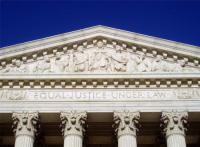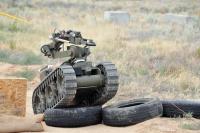-
Separating the DNA of identical twins
Since its first use in the 1980s — a breakthrough dramatized in recent ITV series “Code of a Killer” — DNA profiling has been a vital tool for forensic investigators. Now researchers at the University of Huddersfield have solved one of its few limitations by successfully testing a technique for distinguishing between the DNA — or genetic fingerprint — of identical twins.
-
-
U.K. reviews security measures for large outdoor events
Amber Rudd, the new British home secretary, told the House of Commons that she has ordered a full review of the security measures taken to protect large outdoor events such as festivals and other public gatherings. The review comes in the wake of the attack in Nice on revelers celebrating Bastille Day. Rudd said that additional security measures will be put in place, including what is known as the “national barrier asset” when police assess that there is a risk of vehicle attacks.
-
-
DHS report highlights R&D priorities for technologies used in the field

The Department of Homeland Security has released the Integrated Product Teams for Department of Homeland Security R&D Fiscal Year 2016 Report. The report identifies twenty-four focus areas for technological research and development (R&D), which fall under five mission areas: aviation security, biological threats, border security, cybersecurity, and counterterrorism.
-
-
DHS S&T demonstrates integration of first responder technologies
More ruggedized protective equipment. Reliable and interoperable communications. The capability to filter vast amounts of data. These are all things DHS Science and Technology Directorate (S&T) Next Generation First Responder (NGFR) program envisions to ensure future first responder are better protected, connected, and fully aware.
-
-
Roundup of spring, summer 2016 First Responders Group technology
The DHS S&T regularly posts a roundup of key updates from projects currently in the development stages in S&T’s First Responders Group (FRG). S&T the other day offered an outline of FRG’s accomplishments in April, May, and June.
-
-
NIST releases 3D ballistics research database
It is a staple of the TV-crime drama: a ballistics expert tries to match two bullets using a microscope with a split-screen display. One bullet was recovered from the victim’s body and the other was test-fired from a suspect’s gun. If the striations on the bullets line up — cue the sound of a cell door slamming shut—the bad guy is headed to jail. In the real world, identifying the firearm used in a crime is more complicated. However, the basic setup is correct. New forensic science database will provide a statistical foundation for more reliably linking bullets to the guns that fired them.
-
-
Eyewitnesses who collaborate make fewer mistakes in police interview

Two recent studies show that witnesses make fewer errors when they are interviewed together than when they are interviewed separately. This stands in sharp contrast with current police guidelines to always interview witnesses separately.
-
-
Intelligence agencies spy on our data by manipulating computer chips
Researchers work to develop mechanisms that will render the Internet of Things more secure. They focus on a specific security gap: the manipulation of computer chips, that is, hardware components. These components can be found not only in PCs and laptops, but also in all other devices with integrated electronics; those include credit cards, cars, and smartphones, as well as large industrial facilities and medical equipment.
-
-
FBI's approach to digital investigations puts security at risk: Expert
A cybersecurity expert argues that the FBI’s recent and widely publicized efforts to compel Apple Computer to write software to unlock an iPhone used by a terrorist in California reflects an outdated approach to law enforcement that threatens to weaken the security of all smartphones, potentially putting the private information of millions of smartphone users at risk and undermining the growing use of smartphones as trusted authenticators for accessing online information.
-
-
The accuracy of the FBI’s face-recognition technology may be improved: GAO
The Department of Justice’s (DOJ) Federal Bureau of Investigation (FBI) operates the Next Generation Identification-Interstate Photo System (NGI-IPS) — a face recognition service that allows law enforcement agencies to search a database of over thirty million photos to support criminal investigations. The GAO examined the FBI’s face recognition capabilities, and the extent to which the FBI’s use of face recognition adhered to privacy laws and policies, and the accuracy of these capabilities.
-
-
Hazardous-devices teams compete at the Robot Rodeo, 14-17 June

Hazardous-devices teams from around the Southwest will wrangle their bomb-squad robots at the tenth annual Robot Rodeo beginning Tuesday, 14 June, at Los Alamos National Laboratory. “The Robot Rodeo gives bomb-squad teams the opportunity to practice and hone their skills in a lively but low-risk setting,” said a member of the Laboratory’s hazardous-devices team.
-
-
Move over sniffer dogs: Witnesses can identify criminals by smell
Move over sniffer dogs, people who witnessed a crime are able to identify criminals by their smell. Police lineups normally rely on sight, but nose-witnesses can be just as reliable as eye-witnesses, new research has found. The research shows that humans have the ability to distinguish individuals by their unique body odor.
-
-
DHS announces $40 million funding opportunity for new Criminal Investigations Center of Excellence
DHS S&T earlier this week announced a $40 million funding opportunity for an institution to lead a new DHS Center of Excellence (COE) for Criminal Investigations and Network Analysis. This new COE will conduct end user-focused research to enhance investigation strategies of transnational criminal organizations’ (TCO) activities and other homeland security-related crimes.
-
-
Using lasers to solve hit-and-run whodunit
Scientific sleuths are investigating how a laser-based tool called pump-probe microscopy can be used to differentiate between individual pigments of paint, even if they appear identical to the human eye. The researchers are developing the technique as a way for art historians and conservators peer under the surface of priceless paintings, without causing damage to the artwork, but there is no reason the technique cannot be used for forensics, too.
-
-
Offender risk assessment tools in U.S. are promising, but questions remain
The criminal justice system in the United States uses a variety of tools to assess the behavior of criminal offenders, and those risk assessments can have a significant impact on an offender’s fate. A new meta-analysis of the research conducted in the United States on these tools shows that – while promising – it is still unclear whether these tools reduce bias against offenders based on race or other factors.
-
- All
- Regional
- Water
- Biometrics
- Borders/Immig
- Business
- Cybersecurity
- Detection
- Disasters
- Government
- Infrastructure
- International
- Public health
- Public Safety
- Communication interoperabillity
- Emergency services
- Emergency medical services
- Fire
- First response
- IEDs
- Law Enforcement
- Law Enforcement Technology
- Military technology
- Nonlethal weapons
- Nuclear weapons
- Personal protection equipment
- Police
- Notification /alert systems
- Situational awareness
- Weapons systems
- Sci-Tech
- Sector Reports
- Surveillance
- Transportation
Advertising & Marketing: advertise@newswirepubs.com
Editorial: editor@newswirepubs.com
General: info@newswirepubs.com
2010-2011 © News Wire Publications, LLC News Wire Publications, LLC
220 Old Country Road | Suite 200 | Mineola | New York | 11501
Permissions and Policies
Editorial: editor@newswirepubs.com
General: info@newswirepubs.com
2010-2011 © News Wire Publications, LLC News Wire Publications, LLC
220 Old Country Road | Suite 200 | Mineola | New York | 11501
Permissions and Policies
